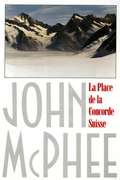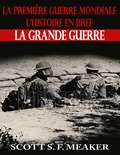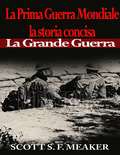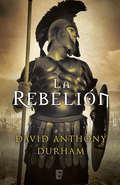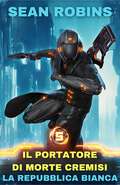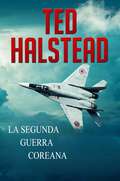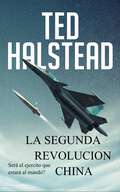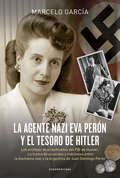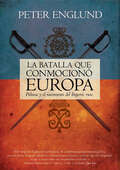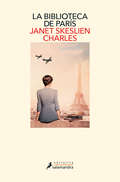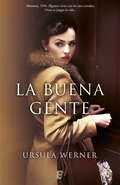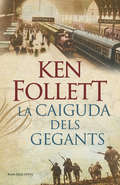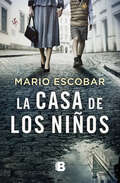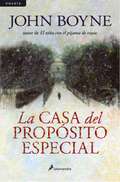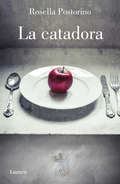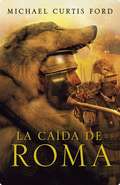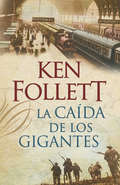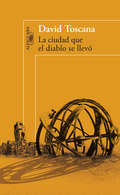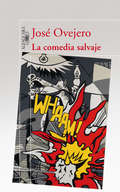- Table View
- List View
La Place De La Concorde Suisse
by John McpheeJohn McPhee embeds himself in a "Section de Renseignements" (military intelligence) of the Swiss Army. This army is more like what we in the U.S. would call the National Guard. Every male Swiss serves in the army for 30 years, but except for an annual 3-week refresher course, lives a normal life (although subject to mobilization within 48 hours at need). McPhee's talent for interviewing his subjects, salting his narrative with history, geography, and even geology, makes this a very informative as well as entertaining book. NOTE: There are a considerable number of French (and some German) words and phrases in this book While it isn't necessary to know French to understand those words and phrases, some knowledge of French would not hurt,
La Première Guerre mondiale: l’Histoire en bref – La Grande Guerre
by Hanène Baatout Scott S. F. MeakerLa Première Guerre mondiale : l'Histoire en bref - La Grande Guerre La Première Guerre mondiale était censée être la dernière de toutes les guerres, d'où son nom de Grande Guerre. La Grande Guerre a pris un mauvais départ selon les Allemands. Le plan était de repousser la France et la Russie tout en se concentrant sur l'objectif principal, en aidant l'Autriche-Hongrie à s'entretenir avec la Serbie. Les pertes en vie humaine, pendant la Grande Guerre, était immense.
La Prima Guerra Mondiale: la storia concisa - La Grande Guerra
by Simona Leggero Scott S. F. MeakerLa Prima Guerra Mondiale doveva essere la guerra che terminava tutte le guerre, da qui il nome la Grande Guerra. La Grande Guerra ebbe un brutto inizio dalla prospettiva della Germania. Il piano era di allontanare la Francia e la Russia mentre lo scopo principale, era aiutare l'Impero austro-ungarico contro la Serbia. La perdita di vita nella Grande Guerra fu immensa.
La Rebelión
by David Anthony DurhamEl nuevo libro del autor del best seller El orgullo de Cartago. Una novela soberbia sobre Espartaco, el legendario gladiador, y la revuelta de esclavos que encabezó y a punto estuvo de someter a Roma y sus invencibles legiones. En esta emocionante novela histórica somos testigos de la rebelión más famosa de la historia desde diversos, y a veces opuestos, puntos de vista, entre ellos el del propio Espartaco, el visionario cautivo y gladiador cuya constancia y carisma convierten la fuga de una prisión en una rebelión multicultural que amenaza a un imperio; el de la profética Astera, cuyo contacto con el mundo de los espíritus y sus augurios guía el desarrollo de la rebelión; el de Nonus, un soldado romano que se mueve a ambos lados del conflicto en un intento, en parte desesperado, de salvar la vida; el de Laelia y Hustus, dos niños pastores incorporados a las tropas de la rebelión de los esclavos, y el de Kaleb, el esclavo al servicio de Craso, el senador romano y comandante que carga con la poco envidiable tarea de aplastar una insurrección de meros esclavos, todo ello en un entorno de violencia, heroísmo y traición. Lo que está en juego con la rebelión de Espartaco es nada menos que el futuro del mundo antiguo. Nadie aporta más brío, inteligencia y frescura a la novela sobre la época clásica que David Anthony Durham. Críticas:«David Anthony Durham es un tipo de talento enorme. Estoy impaciente por leer su próxima novela, sea la que sea.»George R.R. Martin «Durham capta el frenesí de las guerras de la antigüedad de manera extraordinariamente realista... Una novela espléndida, hábilmente estructurada.»The New York Times «Fascinante... Aprovecha con inteligencia lo que se sabe acerca de este periodo remoto... El autor ha especulado e inventado de manera inmejorable.»The Washington Post «Durham entreteje abundantes detalles psicológicos, militares y políticos para crear este vívido relato sobre uno de los periodos más novelados de la historia.»Publisher Weekly
La Repubblica Bianca (Il portatore di morte cremisi - Libro 5 #5)
by Sean RobinsCosa accadrebbe se gli Akakie si trasformassero in Klingon in un universo parallelo? Aiutati dalla loro tecnologia di gran lunga superiore, conquisteranno la loro galassia e poi verranno a prendere la nostra. La marina della Repubblica Bianca decima le forze della Federazione con un attacco a sorpresa. Ora Jim e i suoi amici devono unirsi ancora una volta per cacciare gli invasori e liberare i loro mondi, ma restano solo poche migliaia di astronavi. A peggiorare le cose, il conto alla rovescia scorre e il tempo stringe. I fan della serie bestseller "il portatore di morte cremisi" sanno cosa aspettarsi: posta in gioco alta, battaglie spaziali emozionanti e personaggi indimenticabili. Aggiungete a quell'umorismo campy e abbastanza colpi di scena da far vergognare Alfred Hitchcock, e otterrete "la Repubblica Bianca" in tutta la sua gloria. Leggi oggi un'altra delle epiche avventure di Jim!
La República Española en guerra (1936-1939)
by Helen GrahamUna visión novedosa, exhaustiva y crítica de los orígenes de la Guerra Civil española y su desarrollo. La Guerra Civil es, sin duda, el hecho histórico más importante acaecido en España en el siglo XX y un conflicto cuyas consecuencias, de una forma u otra, llegan hasta la actualidad. Sin embargo, pocas páginas han tratado la evolución política y social de la República durante la guerra, y ninguna con la claridad y el rigor documental de la obra de Helen Graham. El libro analiza la aportación clave de la sociedad civil y sus organizaciones políticas al frente bélico y demuestra que el factor determinante en la evolución de la República entre 1936 y 1939 fue la guerra misma en todas sus facetas. Este trabajo de ardua investigación y síntesis histórica está destinado a convertirse en un libro de referencia imprescindible tanto por la cantidad de información que maneja como por la calidad y profundidad del análisis. La profesora Graham ha escrito un libro brillante y arriesgado que rompe con las maniqueas e interesadas interpretaciones revisionistas de nuestra historia. Reseña:«Este libro es, con mucho, el mejor que he leído en cualquier lengua sobre la Segunda República española durante la Guerra Civil. La narración detallada -y muy analítica- de la evolución de la República supera todo lo que se ha escrito antes. Es una obra fundamental escrita por una historiadora madura en la cumbre de sus capacidades.»Paul Preston
La Segunda Guerra Coreana: Los Agentes rusos Libro 1 (Agentes Rusos #1)
by Ted HalsteadDos agentes rusos descubren que Corea del Norte escondió un arma nuclear desaparecida en una ciudad estadounidense. Otra arma nuclear se acerca a Seúl en un túnel construido por norcoreanos. Y el nuevo dictador militar de Corea del Norte lanza una invasión total. ¿Será Seúl o Pyongyang la nueva capital de una Corea unida?
La Segunda Revolucion China
by Ted HalsteadEl presidente de China se ve enfrentado a muchos problemas, como los conflictos en la frontera india y el Mar de China Meridional, creados por él mismo. Otros que simplemente sucedieron, como los desastres pendientes en la presa de las Tres Gargantas y la planta nuclear más antigua de China,
La agente nazi Eva Perón y el tesoro de Hitler: Los archivos desclasificados del FBI de Hoover. La trama de acuerdos y traiciones entre la Alemania nazi y la Argentina de Juan Domingo Perón
by Marcelo Damian GarcíaUn recorrido por las relaciones entre Juan Domingo Perón, Eva Duarte y el nazismo alemán tras la derrota, avalado por las investigaciones que mandó a realizar Hoover al frente del FBI. Con la debacle nazi consumada, el tablero de la política internacional comienza a reacomodarse. Mientras Adolf Hitler, en el exilio, pierde fuerza e influencia, Juan Domingo Perón -alentado por las circunstancias- se propone erigir a la Argentina como una nación rectora de Sudamérica, tomando la posta de la derrotada Alemania e intentando replicar su ímpetu expansionista en la región. ¿Cómo pretende Perón financiar sus planes de dominación? Mediante el expolio de las millonarias fortunas que fueron secuestradas por el nacionalsocialismo alemán y pacientemente trasladadas hasta Buenos Aires. Su mayor obstáculo será nadie menos que su propia esposa, Eva Duarte, quien pondrá en acción sus poderosas conexiones para salvaguardar esos tesoros. La agente nazi Eva Perón y el tesoro de Hitler nace del trabajo de investigación y consulta de cientos de documentos desclasificados -entre ellos, los de las pesquisas que mandó a hacer John Edgar Hoover cuando se encontraba al frente del FBI-, sobre los cuales el historiador Marcelo García construye una irresistible tesis destinada a entrelazar la inesperada y atrapante trama internacional de acuerdos y traiciones entre la Alemania nazi y la Argentina de Perón. El resultado de este enorme trabajo es un libro que revisa uno de los misterios más magnéticos del peronismo desde una perspectiva nueva: la de los conflictos de intereses entre sus dos más grandes figuras.
La amante del Tercer Reich
by Jennifer Cody EpsteinEl retrato íntimo de una amistad que el nazismo rompió para siempre. Berlín, año 1933. Renate e Ilse se conocen en la escuela y se hacen amigas inseparables, unidas por su pasión por el conocimiento. Pero a medida que el partido nazi gana posiciones en la ciudad, las leyes de Nuremberg pondrán en peligro una amistad que parecía destinada a durar eternamente. Ilse se siente cada vez más atraída por las Juventudes Hitlerianas, mientras que Renate se ve forzada a confrontar un secreto familiar que su familia ha ocultado durante décadas. Una historia de traición y remordimientos que no tendrá su cierre hasta el año 1989, cuando, en Nueva York, Ava Fischer recibe las cenizas de su madre, a la que nunca acabó de conocer bien, junto con un paquete de cartas que no llegaron a enviarse, dirigidas a la mejor amiga de infancia de Ilse, Renate. La crítica ha dicho:«Una absorbente exploración de la amistad, la traición yla posibilidad de cerrar las heridas del pasado.»Booklist
La batalla que conmocionó Europa: Poltava y el nacimiento del Imperio Ruso
by Peter EnglundPoltava y el nacimiento del Imperio Ruso. La batalla de Poltava en 1709 marca el nacimiento del Imperio ruso de Pedro el Grande. En 1700, el zar, de acuerdo con Dinamarca, Sajonia y Polonia, decidió acabar con la hegemonía sueca del norte de Europa. Cuando estas fuerzas internacionales consiguieron derrotar a las tropas del rey Carlos XII en Poltava, Ucrania, empezó el principio del declive y colapso del Imperio sueco y el ascenso de Rusia.Junio de 1709. La guerra dura ya nueve largos años, y el ejército de Carlos XII sitia la ciudad de Poltava, en Ucrania. La caravana a Moscú se ha detenido, y el ejército ruso bajo las órdenes del zar Pedro está solo a cuatro kilómetros de distancia. Los suecos se han estado preparando para la batalla y las tropas, que habían estado desperdigadas por las llanuras de Ucrania, se han congregado. El plan consiste en marchar al amparo de la oscuridad y pillar a los rusos por sorpresa, pero cuando sale el sol todo el plan se desbarata.En este libro se retrata el golpe fatal, hora tras hora, la catástrofe que sesgó 10000 vidas. Se analizan las estrategias en el campo de batalla, los detalles que hacen la historia comprensible, real. A través de los diarios y cartas de los testigos, lo sucedido se llena de las voces de los que estaban allí: el general, sus sirvientes, soldados, el capellán y la viuda de un soldado...
La biblioteca de París
by Janet Skeslien CharlesUna historia de valentía y traición basada en las vicisitudes de los trabajadores de la Biblioteca Americana de París en la Segunda Guerra Mundial. París, 1939. La joven Odile Souchet lo tiene todo: un atractivo novio oficial de policía y un trabajo de ensueño en la Biblioteca Americana de París. Pero cuando estalla la guerra y los nazis marchan sobre París, Odile se expone a perder todo lo que le importa, incluida su querida biblioteca. Sabe que en los momentos difíciles los templos de la cultura peligran porque los libros contienen palabras e ideas prohibidas que deben destruirse. Odile no puede permitir que eso suceda: debe salvar esas páginas, de modo que puedan nutrir la mente de quien llegue después. Junto con sus compañeros, se une a la Resistencia y pone el centro a disposición de los judíos: expulsados de sus casas, tras los libros se sienten seguros, y Odile los defenderá cueste lo que cueste. La crítica ha dicho:«La biblioteca de París es una novela fresca y emocionante que celebra el papel de las bibliotecas como núcleos de comunidad, especialmente cuando las más necesitamos. Nos muestra que la literatura puede ser una vía de escape, un catalizador para la conexión humana y una brújula moral en tiempos oscuros. Una lectura sumamente agradable, con mucho corazón,y rebosante de referencias que harán las delicias de los aficionados a los libros».Matthew Sullivan, autor de Midnight at the Bright Ideas Bookstore «Una carta de amor a París, al poder de los libros y a la belleza de las amistades intergeneracionales».Booklist «Un libro encantandor, rico en detalles... los lectores de literatura histórica se verán atrapados por el realismo de la narración y la amistad que se forja entre una viuda y una joven solitaria».Publisher's Weekly
La buena gente
by Ursula WernerUna novela sobre la Segunda Guerra Mundial inspirada en un caso real: el bisabuelo de Ursula Werner fue secretario de Estado de Economía durante el régimen de Hitler. En su familia no se hablaba de él, hasta que en 2011 la autora encontró una cantidad de cartas y recortes de periódicos ocultos en la casa de su tía, en Hamburgo. Alemania, 1944. Los niños viven su infancia pese a todo, y los adultos intentan mantener los ojos y los oídos cerrados. Mientras tanto, algunos se juegan la vida por ayudar a otros... Cuando estalla la Segunda Guerra Mundial, Edith y Oskar Eberhardt trasladan a su familia -su hija Marina, su yerno Franz y las hijas de estos- desde Berlín hasta una pequeña casa en la tranquila ciudad de Blumental, cerca de Suiza. Oskar, un miembro del gabinete de Hitler, está ausente casi todo el tiempo, y Franz combate en la guerra, de modo que las mujeres de la casa se quedan solas, llevando una existencia tranquila en una pintoresca población. Sin embargo, la vida en Blumental no es tan idílica como parece. Un joven capitán nazi aterroriza a los ciudadanos a quienes debería proteger. Los vecinos se espían mutuamente, y algunos desaparecen de manera misteriosa. Mientras tanto, Marina colabora con un sacerdote protestante que ayuda a refugiados judíos a cruzar la cercana frontera con Suiza. Todo se complicará cuando Oskar regrese a casa con la noticia de que el Führer viajará a la zona y que piensa visitar a los Eberhardt. Reseñas:«La primera novela de Werner sipone una intensa descripción de las luchas interiores libradas por personas normales, impulsadas a hacer cosas extraordinarias en nombre de la familia, de Dios y del país.»Booklist «El coraje, la lealtad, el amor y el suspense atraparán a los lectores.»RT Book Reviews «La autora presenta los dilemas morales de la familia, tanto en su conjunto como individualmente, de manera maravillosa.»Historical Novel Society
La caiguda dels gegants (The Century #Volumen 1)
by Ken FollettUna gran novel·la que narra les vides de cinc famílies: una americana, una gal·lesa, una anglesa, una alemanya i una russa, amb el rerefons de la Primera Guerra Mundial, la Revolució Russa i els profunds canvis socials que aquestes varen comportar. Primer volum de la trilogia «The Century» La història comença el 1911, el dia de la coronació del rei Jordi V a l'abadia de Westminster. El destí dels Williams, una família minera de Gal·les, està unit per l'amor i l'enemistat al dels Fitzherbert, aristòcrates i propietaris de les mines. Lady Maud Fitzherbert s'enamorarà de Walter von Ulrich, un jove espia a l'ambaixada alemanya a Londres. Les seves vides s'entrellaçaran amb la d'un assessor progressista del president dels Estats Units, Woodrow Wilson, i les de dos germans russos als quals la guerra i la revolució han arrabassat el somni de buscar fortuna a Amèrica. Des de Washington fins a Sant Petesburg, des de la immundícia i els perills de les mines de carbó fins als luxosos canelobres dels palaus aristocràtics, passant pels passadissos de la Casa Blanca i el Parlament de Westminster, Ken Follet ens ofereix, en la seva novel·la més ambiciosa, l'acurat retrat d'una època i de les passions que van sacsejar la vida dels seus personatges. «La trilogia "The Century" és la història dels meus avis i dels vostres, dels nostres pares i de les nostres vides. D'alguna manera, és la història de tots nosaltres.»Ken Follet La crítica ha dit...«Alta política i baixes passions (i viceversa) conformen un fulletó de gran dimensions que confirma a Follett com a mestre rellotger del regne del best seller.»Qué Leer «Ken Follett no és un escriptor, sinó un fenomen social.»El Cultural de El Mundo
La casa de los niños
by Mario EscobarUna novela fascinante sobre la historia real de tres héroes holandeses que, como Oskar Schindler, decidieron desafiar al horror y salvaron la vida de más de seiscientos niños judíos. LA GRANDEZA HUMANA PUEDE SURGIR ENTRE LAS RUINAS DE LA GUERRA Ámsterdam, 1942. En Holanda ya ondea la bandera nazi y miles de judíos aguardan el día de su deportación en lugares como el Teatro Hollandsche Shouwburg. El profesor Johan van Hulst es testigo de las condiciones en las que esperan los niños judíos, atemorizados y sin sustento, y es incapaz de quedarse impasible ante tanto sufrimiento. SALVAR LA VIDA DE CIENTOS DE NIÑOS FUE SU LEGADO Para hacer frente a la tragedia, se pondrá en contacto con Henriëtte Pimentel —la directora de la guardería más cercana— y con Walter Süskind —el judío alemán obligado a redactar las listas de deportados—. Juntos diseñarán un entramado de pasadizos a través del cual intentarán salvar a los niños, mientras se esconden de los ojos de un régimen cada día más despiadado… ESTA ES SU HISTORIA A través del relato de una familia sefardí que intenta escapar de su horrible destino, Mario Escobar nos descubre la historia real de las personas que salvaron a más de seiscientos niños en el momento más feroz del nazismo. Grandiosa y conmovedora, esta novela rinde homenaje a todos aquellos héroes sin armas ni banderas que no dudaron en poner en peligro su vida por la de los demás.
La casa del propósito especial
by John BoyneBoyne mantiene vivo el interés hasta las últimas páginas, en las que un inesperado desenlace dejará, una vez más, una profunda huella en los lectores. Mientras acompaña a su esposa Zoya, que agoniza en un hospital de Londres, Georgi Danilovich Yáchmenev rememora la vida que han compartido durante sesenta y cinco años, una vida marcada por un gran secreto que nunca ha salido a la luz. Los recuerdos se agolpan en una sucesión de imágenes imborrables, a partir de aquel lejano día en que Georgi abandonó su mísero pueblo natal para formar parte de la guardia personal de Alexis Romanov, el único hijo varón del zar Nicolás II. Así, la fastuosa vida en el Palacio de Invierno, las intimidades de la familia imperial, los hechos que precedieron a la revolución bolchevique y, finalmente, la reclusión y posterior ejecución de los Romanov se entremezclan con el durísimo exilio en París y Londres en una hermosa historia de un amor improbable, al mismo tiempo un apasionante relato histórico y una conmovedora tragedia íntima. Tras asombrar al público y la crítica con El niño con el pijama de rayas #libro de ficción más vendido en España en 2007 y 2008# y seducir a miles de lectores con su siguiente obra, Motín en la Bounty, John Boyne vuelve a demostrar un especial don narrativo para tratar grandes acontecimientos históricos desde perspectivas desconocidas, proyectando sobre lo ya sabido una luz nueva y sorprendente.
La catadora
by Rosella PostorinoUNA GRAN NOVELA ACLAMADA POR LA CRÍTICA Y EN LA LISTA DE MÁS VENDIDOS DE ITALIA GANADORA DEL PREMIO CAMPIELLO «Por favor, leed este libro.» Michela Murgia (autora de La acabadora) «Un libro necesario y poderoso que recuerda a Primo Levi.» La Riviera Imaginen por un momento una mesa bien dispuesta, con platos de loza blanca llenos de comida exquisita. Imaginen unas judías verdes condimentadas con mantequilla fundida, el olor embriagador de unos pimientos asados y la textura de un Strudel de manzana recién horneado. Al levantar la vista encontrarán a diez mujeres jóvenes y famélicas. Estamos en el cuartel general de Hitler y corre el año 1943; la guerra causa estragos, pero ellas están aquí y tienen hambre. Lo que pueda pasar después poco importa... «¡Comed!», ordenan los soldados de la SS: ellas son las catadoras del Führer y tendrán que aguardar una hora hasta que los guardias descarten que las viandas están envenenadas. En el ambiente turbio de este banquete perverso, que siempre puede ser el último, las jóvenes y los militares del cuartel trenzan alianzas insólitas. Pero ¿acaso hay algo insólito cuando vivimos al límite? Inspirándose en la historia real de Margot Wölk, catadora de Hitler, Rosella Postorino atraviesa el laberinto del deseo para contarnos la historia de Rosa Sauer, una joven que se aferra a su afán por saborearlo todo, incluido el sexo prohibido, mientras espera a un marido que no regresa: una mujer con ganas de sentirse viva. «Cala tan hondo este paisaje humano y psicológico que, al leerla, te ves reflejado. [...] Una narración construida con maestría.» Benedetta Tobagi, La Repubblica La crítica ha dicho...«Por favor, leed este libro.»Michela Murgia (autora de La acabadora) «Desde la primera página supe que tenía que publicarlo. Me recordó a El lector, de Bernhard Schlink, pero al mismo tiempo es una historia nunca escuchada, única.»Amy Einhorn, editora de Flatiron Books «Rosella Postorino usa las migas, las viandas y el cuerpo como lenguaje. [...] Su escritura precisa y rica se mueve en distintos planos y consigue evocar, desde la ausencia,elcuerpomismo de Hitler. [...] La autora dirige con maestría el coro de las catadoras, define sus perfiles, indaga en las relaciones de fuerza y complicidad que se instauran, los secretos y los pecados que descansan en lomás profundo del ánimo de estas mujeres.»Cristina Taglietti, Corriere della Sera «Un libro con un sabor que conmueve, que sabe a pasteles crujientes y especiados, a exquisiteces inimaginables en tiempo de guerra. Habla de vida plena de un tiempo que se queda en suspenso: es el tiempo de la ansiedad, tras cada comida, hasta saber si se nos va a conceder un día más.»L'Espresso
La catadora
by Rosella PostorinoUna gran novela aclamada por la crítica y en la lista de más vendidos de Italia. Ganadora del Premio Campiello y el Prix Jean Monnet for European literature «Por favor, leed este libro.»Michela Murgia (autora de La acabadora) Imaginen por un momento una mesa bien dispuesta, con platos de loza blanca llenos de comida exquisita. Imaginen unas judías verdes condimentadas con mantequilla fundida, el olor embriagador de unos pimientos asados y la textura de un Strudel de manzana recién horneado. Al levantar la vista encontrarán a diez mujeres jóvenes y famélicas. Estamos en el cuartel general de Hitler y corre el año 1943; la guerra causa estragos, pero ellas están aquí y tienen hambre. Lo que pueda pasar después poco importa... «¡Comed!», ordenan los soldados de la SS: ellas son las catadoras del Führer y tendrán que aguardar una hora hasta que los guardias descarten que las viandas están envenenadas. En el ambiente turbio de este banquete perverso, que siempre puede ser el último, las jóvenes y los militares del cuartel trenzan alianzas insólitas. Pero ¿acaso hay algo insólito cuando vivimos al límite? Inspirándose en la historia real de Margot Wölk, catadora de Hitler, Rosella Postorino atraviesa el laberinto del deseo para contarnos la historia de Rosa Sauer, una joven que se aferra a su afán por saborearlo todo, incluido el sexo prohibido, mientras espera a un marido que no regresa: una mujer con ganas de sentirse viva. La crítica ha dicho...«La catadora se escribe con una prosa recia y áspera, con un fraseo amplio y trabajado y una mirada crítica y penetrante al ambiente, a la vida de las gentes y del país. Novela de desolada cosmovisión; narración sólida y desnuda en lo expresivo. Impacta hondamente.»Luis Alonso Girgado, El Ideal «Postorino tiene la habilidad de transmitir en un solo gesto y a la perfección los sentimientos de culpa, vergüenza, amor y remordimiento. Tendremos más noticias suyas.»Susan Ellingwood, The New York Times «Cala tan hondo este paisaje humano y psicológico que, al leerla, te ves reflejado. [...] Una narración construida con maestría.»Benedetta Tobagi, La Repubblica «Un libro necesario y poderoso que recuerda a Primo Levi.»La Riviera «Una historia muy atractiva, original.»Mercedes Suero, A golpe de letra «Rosella Postorino usa las migas, las viandas y el cuerpo como lenguaje. [...] Su escritura precisa y rica se mueve en distintos planos y consigue evocar, desde la ausencia, el cuerpo mismo de Hitler. [...] La autora dirige con maestría el coro de las catadoras, define sus perfiles, indaga en las relaciones de fuerza y complicidad que se instauran, los secretos y los pecados que descansan en lo más profundo del ánimo de estas mujeres.»Cristina Taglietti, Corriere della Sera «Un libro con un sabor que conmueve, que sabe a pasteles crujientes y especiados, a exquisiteces inimaginables en tiempo de guerra. Habla de vida plena de un tiempo que se queda en suspenso: es el tiempo de la ansiedad, tras cada comida, hasta saber si se nos va a conceder un día más.»L'Espresso «Desde la primera página supe que tenía que publicarlo. Me recordó a El lector, de Bernhard Schlink, pero al mismo tiempo es una historia nunca escuchada, única.»Amy Einhorn, editora de Flatiron Books «El retrato de una mujer que quedará para siempre en la mente de los lectores.»Luca Mirarchi, Blow Up «Una historia poderosa narrada de manera implacable y fascinante.»Titti Marrone, Il Mattino «Una novela que se lee, de principio a fin, con un nudo en la garganta y un constante sentimiento de identificación.»Annalena Benini, Io Donna «Es ya la
La caída de Roma
by Michael Curtis FordUna vivaz y espectacular recreación del declive del más poderoso imperio de todos los tiempos. Ya en sus postrimerías, el Imperio romano está en manos de los bárbaros. El propio Atila, debilitado por las escisiones de sus aliados, muere, y el ambicioso Orestes saquea su tumba y acusa de la profanación a sus rivales políticos, los hermanos Omulf y Odoacer. A partir de ahí se sucederán las luchas entre clanes y líderes militares dentro de las propias legiones romanas, hasta culminar en la caída del principal símbolo del poder imperial: la ciudad de Roma. Michael Curtis Ford describe con gran pulso narrativo una época fascinante y prácticamente desconocida para la mayoría de lectores
La caída de los gigantes (The Century #Volumen 1)
by Ken FollettUna gran novela que narra las vidas de cinco familias: una americana, una galesa, una inglesa, una alemana y una rusa, con el trasfondo de la Primera Guerra Mundial, la Revolución Rusa y los profundos cambios sociales que estas conllevaron. Primer volumen de la trilogía «The Century» La historia empieza en 1911, el día de la coronación del rey Jorge V en la abadía de Westminster. El destino de los Williams, una familia minera de Gales, está unido por el amor y la enemistad al de los Fitzherbert, aristócratas y propietarios de las minas. Lady Maud Fitzherbert se enamorará de Walter von Ulrich, un joven espía en la embajada alemana en Londres. Sus vidas se entrelazarán con la de un asesor progresista del presidente de Estados Unidos, Woodrow Wilson, y la de dos hermanos rusos a los que la guerra y la revolución les ha arrebatado su sueño de buscar fortuna en América. Desde Washington hastaSan Petesburgo, desde la inmundicia y los peligros de las minas de carbón hasta los candelabros lujosos de los palacios de la aristocracia, pasando por los pasillos de la Casa Blanca y el parlamento de Westminster, Ken Follet nos ofrece, en su novela más ambiciosa, un esmerado retrato de una época y de las pasiones que espolearon la vida de sus personajes. «La trilogía "The Century" es la historia de mis abuelos y de los vuestros, de nuestros padres y de nuestras vidas. De alguna forma es la historia de todos nosotros.»Ken Follet La crítica ha dicho...«Alta política y bajas pasiones (y viceversa) conforman un folletín de grandes dimensiones que confirma a Follett como relojero mayor del reino del best seller.»Qué Leer «Ken Follett no es un escritor, sino un fenómeno social.»El Cultural de El Mundo
La chica que escapó de Auschwitz
by Ellie MidwoodMillones de personas atravesaron las puertas de Auschwitz, pero ella fue la primera mujer que escapó. La increíble historia real de Mala Zimetbaum. Un libro ideal para los lectores de El tatuador de Auschwitz y Las 999 mujeres de Auschwitz. Millones de personas atravesaron las puertass de Auschwitz, pero ella fue la primera mujer que escapó.Esta poderosa novela narra la inspiradora historia real de Mala Zimetbaum, cuyo heroísmo nunca será olvidado, y cuyo destino alteró el curso de la historia. Nadie sale vivo de Auschwitz. Mala, reclusa 19880, lo entendió en el momento en que bajó del tren de ganado para dirigirse a las profundidades del infierno. Como intérprete de las SS, Mala usó su posición para salvar tantas vidas como pudo.Edward, recluso 531, es un veterano del campo y un preso político. Aunque, con la cabeza rapada y el uniforme a rayas, se parezca a todos lo demás, es un luchador de la Resistencia en la clandestinidad. Y tiene un plan de escape. Sabe que, a pesar de estar rodeado por cables eléctricos, ametralladoras coronando interminables torres de vigilancia y reflectores vagando por el suelo, dejarán, tanto él como Mala, el campo de exterminio. Hay la promesa de escapar juntos o morir juntos, en una de las más grandes historias de amor de todos los tiempos. Los lectores han opinado:«No podía dejarlo, lo estuve leyendo toda la noche... Una historia hermosa y desgarradora; una historia que leí con los ojos borrosos debido a todas las lágrimas. Una lectura obligatoria para todos. Este libro se quedará conmigo para siempre.»@bookswithmitch «Extraordinario... Devastadoramente desgarrador... Absolutamente repleto de emociones que te harán sonreír, llorar y reír.»Bookworm86«Imposible dejarlo... El libro fue absolutamente apasionante.»RK Lee «Uno de los libros mejor documentados de los muchos que he leído ambientados en la Segunda Guerra Mundial.»La biblioteca de Meri«Emotivo y desgarrador.»Tropical Girl Reads Books «No podía dejar de leer esta historia y definitivamente tocó las fibras de mi corazón. Me encantó leer la historia de Mala.»Heather Loves to Read«El libro más duro que he leído sobre esta temática. Una historia llena de dolor y tristeza, pero a pesar de ello también es una historia de amor, generosidad y complicidad.»Lectura con pasión «Una historia que paraliza el corazón.»Hormiguero de libros
La ciudad que el diablo se llevó
by David ToscanaCuatro sobrevivientes de la Segunda Guerra Mundial intentan sobrellevar sus vidas en medio de la reconstrucción de Varsovia. De David Toscana, el autor de Estación Tula y Los puentes de Königsberg. Al final, aunque todo salió mal, todos se creyeron héroes. David Toscana reinventa una ciudad herida donde la realidad se vence con imaginación, nostalgia, rebeldía y una buena dosis de alcohol. Tras la ocupación alemana, Varsovia es una ciudad en ruinas, habitada por personas que casi lo perdieron todo y ahora, bajo el yugo rojo, tienen que encontrarle un sentido a su existencia. No basta con la idea de un futuro posible. Primero es necesario sobrevivir. Hacerlo entre escombros es la proeza de los verdaderos héroes; aquellos que supieron encontrar la belleza escondida tras los bombardeos, en el gueto o en esa extraña amistad que se da entre los caídos. La ciudad que el diablo se llevó muestra los sinsentidos de la condición humana: el peso de la tragedia judía en un antisemita, el dolor de un novelista que ha perdido su novela, las mañas de un enterrador en la capital de la muerte, el comercio de objetos saqueados, una supuesta victoria que sabe a múltiples derrotas. Lo que ha dicho la crítica: "David Toscana da una nueva cátedra de una prosa novedosa, sofisticada y efectiva que paradójicamente abreva de los clásicos y que (cosa extraña en nuestros días) sabe llamar a cada cosa por su nombre". -Tryno Maldonado, revista Emeequis. "La ciudad que el diablo se llevó es una novela fantástica, y con esto no me refiero al género fantástico sino a su calidad narrativa y estructural. [...] muy pocos se sentirán decepcionados de acompañar a los cuatro borrachines de La ciudad que el diablo se llevó". -Gerardo Lima, Letrearte, Revista literaria del Fondo Regional para la Cultura y las Artes del Noroeste de México.
La comadrona
by Katja KettuÉrase una vez FinlandiaTraducida a catorce idiomas«Una gran novela. Una historia de amor aderezada con una pizca de realismo mágico y un puñado de durísimas verdades... Kettu sirve un plato de entrañas bien caliente: aterrador y fascinante.» Jurado del Premio RunebergLaponia, 1944: hasta los rincones más inhóspitos de Finlandia llegan los ecos de la Segunda Guerra Mundial. Por las venas de la comadrona fluye la sangre de un padre comunista salvajemente represaliado. Desde su infancia vive aislada de una sociedad que la desprecia. Pero su mundo sufre un vuelco cuando un enigmático oficial alemán de las SS la descubre con un cordón umbilical entre los dientes: es la primera vez que alguien la mira de verdad. Su amor la impulsa a seguir a Johannes hasta el campo de prisioneros al que ha sido enviado y más allá. Hasta la muerte si es necesario.La crítica ha dicho:«La ferocidad del amor podría ser un buen título para la novela de Katja Kettu. Todo es feroz en este libro, también el estilo. Un libro que no se olvida, gélido e incandescente, brutalmente pasional.» Marilia Piccone, Wuz.it (Italia)«Una novela asombrosa, con un alma descarnada y una energía liberadora. No me sorprendería que acabara convirtiéndose en un clásico.»Cecilia Nelson, Göteborgs-Posten (Suecia)«Sorprendentemente maravillosa... Una increíble experiencia de lectura.»Turun Sanomat (Finlandia)«Una descripción cruda y desnuda de qué puede hacer la guerra con el ser humano y dónde puede llevarte el amor.» Adresseavisen (Noruega)«Puedo afirmar que tengo entre las manos uno de los libros más exitosos e importantes del año. Me atrevo a compararlo con Purga, de Sofi Oksanen. Así de grande es.»Seppo Puttonen, Ykkösen Aamu-tv (Finlandia) «Una obra maestra.»Raili Kettunen, Kotimaa (Finlandia)«Una de las novelas más profundas que he leído en mucho tiempo... Rebosa sensualidad y nostalgia. Es hipnótica, no puedes apartarte de ella.»Annina Rabe, Svenska Dagbladet (Suecia)«No es un libro que se lea, es un libro que se vive hasta el último aliento. Es imposible salir indemne de él.» Dagens Nyheter (Suecia)«Leer La comadrona es una experiencia asombrosa, que oscila entre el horror y el fervor.»Smålandsposten (Suecia)«Impresionante por su tono, por la trama, por el lenguaje... Una historia que llega a todos los confines, de la tierra y de la humanidad. Un libro fascinante.» Marie-Paule Caire, Parutions.com (Francia)
La comedia salvaje
by José OvejeroBenjamín ha recibido una misión que se le antoja desmesurada: detener la Guerra Civil. Aunque Benjamín no cree que sea posible, recorrerá un país que se ha lanzado, al parecer con entusiasmo, a su propia destrucción. Y de camino irá encontrando estrambóticos personajes, apariciones delirantes que le harán pensar que se ha vuelto loco. Menos mal que ahí está la mano de Julia para devolverle de vez en cuando a la realidad. Esta novela es un disparate. Un mundo de alucinación, en el que las escenas realistas conviven con sucesos imposibles, aunque nunca se sabe si las situaciones más esperpénticas están sacadas de la realidad o de la imaginación del escritor. En La comedia salvaje no hay héroes ni biografías ejemplares. Más que un libro sobre la Guerra Civil, éste es un libro sobre la guerra, sobre todas las guerras. Las voces de Cervantes, Valle-Inclán y Kurt Vonnegut, resuenan en esta novela que es, también, una reflexión lúdica sobre la utilidad de la literatura.
La criatura del deseo
by Andrea CamilleriBasándose en personajes y hechos reales, Andrea Camilleri reconstruyela tormentosa relación entre Alma Mahler y Oskar Kokoschka En 1912, un año después de la muerte de Gustav Mahler, Alma, su joven viuda conoció al pintor Oskar Kokoschka. Así comienza su historia de amor, que pronto desembocará en una pasión tan desenfrenada como tumultuosa. Pero cuando Alma rompe brutalmente la relación, Kokoschka, con el corazón destrozado, decide partir al frente. A su regreso, traumatizado por el conflicto y obsesionado aún con el amor perdido, encarga una muñeca de tamaño natural con los rasgos de su amada. A partir de escritos biográficos, cartas y otros materiales inéditos, Andrea Camilleri reconstruye no solo la sobrecogedora historia de una desenfrenada pasión amorosa, en la que pugnan el genio artístico y la enfermedad mental, sino también una época crucial para el destino de Europa. La crítica ha dicho... «Por su capacidad para ahondar en un mundo que ya había visitado tanto y descubrir cosas nuevas, las novelas criminales o novelas negras de Camilleri ajenas al universo de Montalbano son su derivada más interesante.» El País«A partir de escritos biográficos, cartas y otros materiales inéditos, el siciliano ofrece una historia de pasión desenfrenada.» El Debate «Una historia asombrosa y verídica. Una crónica perversa en la que Kokoschka ejecuta con furia la matanza simbólica de una mujer rebelde. Un mundo de proyecciones y mitos. El sueño de Pigmalión. Doctor Coppelius y Coppelia, su codiciado maniquí. Los fetiches eróticos de los cuerpos hinchables.» La Repubblica
